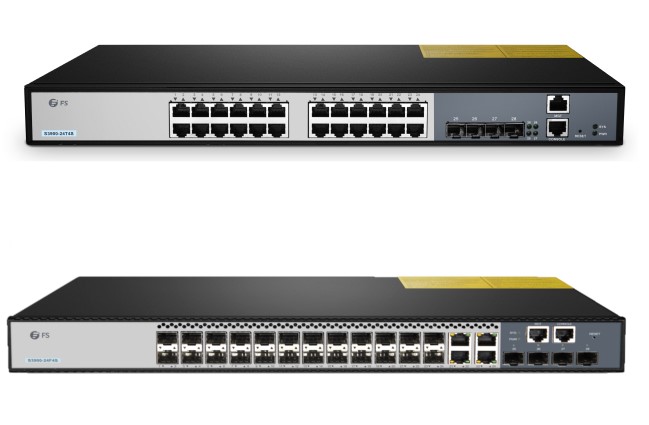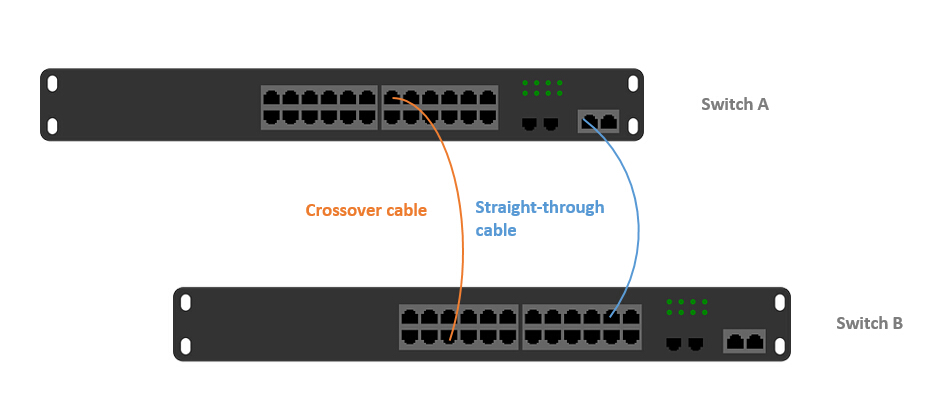Networks will eventually grow to a state that we need to integrate more switches to increase port density and boost bandwidth. Then, should we buy network switch with more ports or just connecting switch via stacking or uplink. Obviously, the latter one is better. Switch stacking vs uplink, what is the difference between them? When to choose which? This article tries to shed some light on the pros and cons of switch stacking vs uplink, and help you make the right decision.
What Is Switch Stacking?
Let’s start from switch stacking. By stacking switches together, you are allowed to manage multiple switches as a single entity with a typically increased bandwidth between switches. Switch stacking can be done by connecting switch backplane via a stacking cable. Stacking cable is specified for stacking switch that comes with the switch. Staking switch makes it very convenient and easy to configure multiple switches from a single console. Stacking can be seen as a single entity. You manage one device rather than each stack member. Besides, you manage several stacking switches with only one IP address. This significantly enhances network efficiency while simplifies management.

Generally, a stackable switch has a dedicated port for stacking via special cable or module, which brings higher costs. However, some stack-capable switches are embedded with uplink ports for stacking to minimize the cost. For example, these FS managed Gigabit stackable switch (S3900-24T4S) and managed Gigabit stackable SFP switch (S3900-24F4S).

What Is Uplink Port on Network Switch?
An uplink port is a port on which transmit and receive are reversed. It is designed for inner-switch connection with a standard straight-through cable. Otherwise, it would require a crossover cable, through which the transmit and receive are crossed in the cable rather than on the switch port. Plug the uplink port of one switch into the standard port of another switch cab to help expand the network’s size. When you connect two devices, the uplink port on only one of them is used. If you connect two uplink ports with straight-through cable, the result is the same as using two conventional ports – makes the devices fail to communicate.

Switch Stacking vs Uplink: How to Choose?
Some may still hesitate when choosing switch stacking vs uplink. Simply put it, switch stacking is a great fit for limited space deployment where flexibility trumps availability. Being a pay-as-you-grow model, switch stacking is attractive for users that need flexibility in their physical network and in the amount of needed traffic. It gives you the resilience to operate them as a part of a stack today, or as individual switch tomorrow. Besides, stacking offers more bandwidth while simplifies network management, proven as a more cost-effective alternative to chassis-based higher-end switches. However, stacking is only for a stackable switch in the same product family of the same vendor, and the connecting distance is limited by the length of stacking cable – often within wiring closet.
Switch uplink not only relieves you from having to use a crossover cable between two standard Ethernet ports. It also offers a perfect fit for connecting switches from different product family or even different vendor, enabling much more flexibility to your infrastructure. Moreover, leveraging the standard Cat5e/Cat6 cable, switch uplink extends the linking distance up to 100 m. If your switches are located over 100 m, you can put another switch in between as the bridge. Compared switch stacking vs uplink, switch uplink only provides very limited bandwidth increase. In some cases, users can benefit from using both switch stacking and uplink.
Conclusion
Switch stacking vs uplink, as two critical methods to increase switch ports, has their own benefits and drawbacks. As always, the most important part is to determine what your requirements are. We have gone through both the pros and the cons of switch stacking vs uplink, wish it may help you to make a valid decision for your network.
Related Article: 24-Port Managed PoE Switch: A Must-have for Your Network
FS.COM LAN Access 10G Switch Analysis




